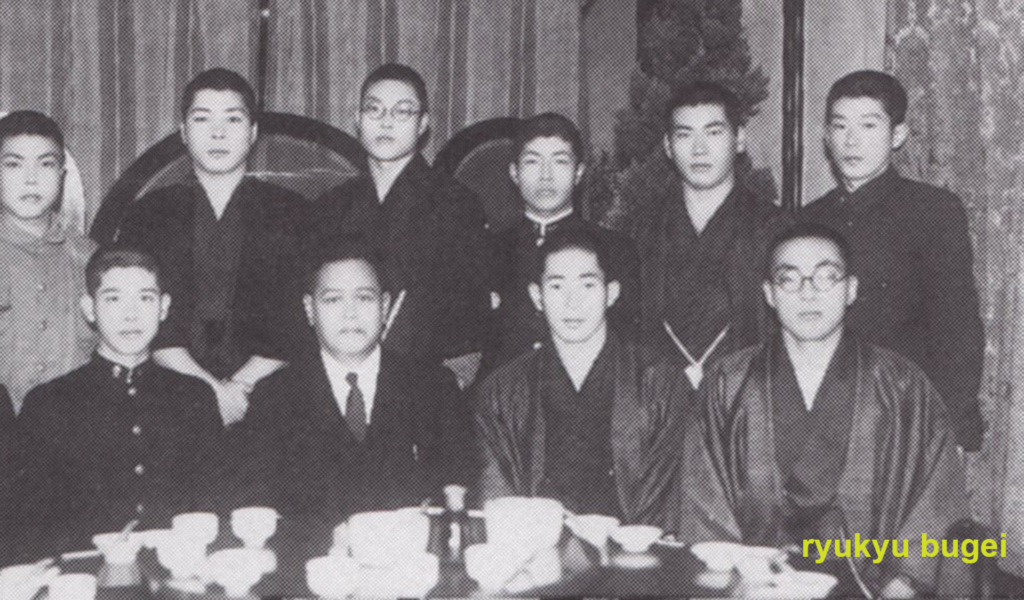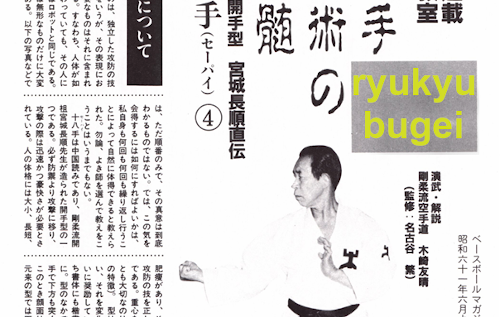Not too long ago communication between Okinawa and the world as well as between sensei and students was slow. Things would sometimes take months if not years to reach anybody, if ever.
My colleague Filip Konjokrad just provided his translation of the recent interview with Sadayuki Taira published in the Okinawa Times. It is super-interesting for several reasons, most importantly for its note on the origin of Sēpai, a famous kata of the Gōjū-ryū school of karate. There it is said:
Seipai (18 hands) is a kata made by Chojun Miyagi sensei (1888-1953), the founder of Goju-ryu.
BTW, around twenty years ago I came across the same statement in a 1986 article from a karate mag. It was written by Kisaki Tomoharu, founder of Yuishinkan Gōjū-ryū karate–dō. Most people know him indirectly because he was the initiator of the commemorative monument for Higashionna Kanryō and Miyagi Chōjun at Matsuyama Park in Naha. It is funny not even Okinawan sensei ever heard about that but Kisaki actually chose the stone for the monument in Fuzhou and had the front characters chiseled in by a Chinese master carver.
What also none of the persons knew that I talked to in Okinawa was that the names of those who participated in the erection of the monument are all written on the foundation stone. That stone memorial for Higashionna Kanryō and Miyagi Chōjun was solemnly unveiled on May 23, 1987, commemorating Miyagi Chōjun’s centenary birthday.
Here follows the part in question on Sēpai, plus a few more excerpts from the 1986 article. Back then we were all stunned and wondered if the translation was correct, but there was no doubt. I stopped talking about it many years ago. People were rather contemptuous towards the idea that Sēpai might not be a century-old kata from China handed down by Higashionna to Miyagi.
Sēpai is the Chinese pronunciation of the characters and it is one of the open-skill kata (kaishu-gata) created by Miyagi Chōjun himself, the founder of Gōjū-ryū. The movements always switch over from defense to attack, in which great speed and dynamism is required for the attacks.
[…]
When performing the kata you have to stick to the basic forms of the movements as much as possible. As part of and as a sign of progress in kata, however, the founder Miyagi Chōjun himself expressly supported and encouraged the process of varying these movements. That means, as in calligraphy, where different types of writing exist such as block letters, semi-italic letters and italics.
In the kata, shiko-dachi is used to thrust down with both hands. At that moment the face is facing forward. In the original kata, however, it was correct to look down in the direction of the thrust.
Nowadays, however, there are groups that even simplify and modify the Kata Sanchin, which is the basis of Gōjū-ryū, so that it is easier to learn and teach. This is a big mistake in kata practice. A foundation must remain a foundation. It seems to have been forgotten that karate in itself is the hard part of it all.
In summary: only those who continue practice (in Okinawa it is called “the suffering”) continuously and repeatedly can acquire the kata.
Kisaki Tomoharu.
I might add that Sēpai is very specific when it comes to techniques. It does not have the typical Gōjū-ryū opening of Sanchin and others and features a variety of locks and twists of various body parts rather than emphasizing classical uke, tsuki, and keri techniques. That is, it is full of torite-class techniques, or tuidi in Okinawan pronunciation.
Another important point is that – if it is true that Miyagi created it – there is a chance that Okinawan karate people created new kata during the early 20th century and gave them names that sounded as if they were taken from the Chinese language and corrupted to old-style Ryūkyūan language. This is a point to consider when it comes to the issue of the “invention of karate,” i.e. the chance that karate was not really that old but rather a 20th century invention, albeit based on traditional physical culture and fragmentary martial arts traditions of bygone eras.
Source: Kisaki Tomoharu: Sēpai, Part 1. The True Essence of Karate Technique. Gōjū-ryū Kaishugata: Learned in Personal Instruction from Miyagi Chōjun. Kindai Karate, Juni 1986 (Issue Nr. 25). Tōkyō, Bēsubōru Magajin-sha 1986.
Note: The article in copy was given to me by Christian Winkler Sensei. A German translation was provided by Rina Obi Sensei shortly afterwards. The late Uli Schlee Sensei’s was also involved in the project.
© 2021, Andreas Quast. All rights reserved.


